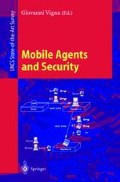Abstract
In this paper, we introduce a collection of cryptographic key constructions built from environmental data that are resistant to adversarial analysis and deceit. We expound upon their properties and discuss some possible applications; the primary envisioned use of these constructions is in the creation of mobile agents whose analysis does not reveal their exact purpose.
James Riordan is now with the IBM Zurich Research Laboratory in Switzerland.
Access this chapter
Tax calculation will be finalised at checkout
Purchases are for personal use only
Preview
Unable to display preview. Download preview PDF.
References
AT&T, Telephone Security Device 3600-User’s Manual, AT&T, 1992.
W. Diffie, P.C. can Oorschot, and M.J. Weiner, “Authentication and Authenticated Key Exchanges,” Designs, Codes, and Cryptography, v. 2, 1992, pp. 107–125.
H. Dobbertin, A. Bosselaers, and B. Preneel, “RIPEMD-160: A Strengthened Version of RIEPMD,” Fast Software Encryption, Third International Workshop, Springer-Verlag, 1996, pp. 71–82.
T. ElGamal, A Public-Key Cryptosystem and a Signature Scheme Based on Discrete Logarithms, IEEE Transactions on Information Theory, IT-31 (1985) 469–472.
D.V. Klein, “Foiling the Cracker: A Security of, and Implications to, Password Security,” Proceedings of the USENIX UNIX Security Workshop, Aug 1990, pp. 5–14.
E.D. Myers, “STU-III—Multilevel Secure Computer Interface,” Proceedings of the Tenth Annual Computer Security Applications Conference, IEEE Computer Society Press, 1994, pp. 170–179.
National Institute of Standards and Technology, NIST FIPS PUB 180, “Secure Hash Standard,” U.S. Department of Commerce, May 1993.
R. Rivest, A. Shamir, and L. Adleman, “A Method for Obtaining Digital Signatures and Public-Key Cryptosystems,” Communications of the ACM, v. 21, n. 2, Feb 1978, pp. 120–126.
Author information
Authors and Affiliations
Editor information
Editors and Affiliations
Rights and permissions
Copyright information
© 1998 Springer-Verlag Berlin Heidelberg
About this chapter
Cite this chapter
Riordan, J., Schneier, B. (1998). Environmental Key Generation Towards Clueless Agents. In: Vigna, G. (eds) Mobile Agents and Security. Lecture Notes in Computer Science, vol 1419. Springer, Berlin, Heidelberg. https://doi.org/10.1007/3-540-68671-1_2
Download citation
DOI: https://doi.org/10.1007/3-540-68671-1_2
Published:
Publisher Name: Springer, Berlin, Heidelberg
Print ISBN: 978-3-540-64792-8
Online ISBN: 978-3-540-68671-2
eBook Packages: Springer Book Archive

